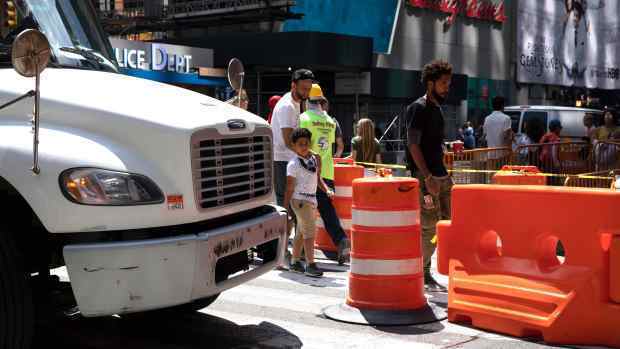Welcome Back to School, Kids — Now, Run for Your Lives!

Readin’, ritin’ and riskin’ your life.
As they return to in-person classes on Monday, New York City public school children are at greater danger than they were just one day earlier, thanks to the increase in car and bus driving that historically has begun after the first day of classes.
A Streetsblog review of city crash data shows that the sheer number of collisions on city streets is an average of nearly 9 percent higher, likely because so many people return to the roads as a method of getting their children to school.

In some recent years, the number of crashes on the first day of school are higher than the previous day by double-digit percentages:
- In 2014, there were 727 crashes on the opening day of school, Sept. 4, up from 580 the day before.
- In 2016, there were 717 crashes on the opening day of school, Sept. 8, up from 648 the day before.
- In 2017, there were 790 crashes on the opening day of school, Sept. 7, up from 608 the day before.
- And in 2019, the last time there was a real New York City opening day of school, there were 628 crashes, up from 600 the day before.
As the chart above shows, only two years have not met the same pattern, with a slight decrease in crashes in 2018 and a slightly larger decrease in 2015. But the decline in opening day crashes has never reached double-digits, but the increase in crashes has done so three times since 2014.
In all those opening-day-of-school crashes since 2014, 843 people have been injured. The average number of citywide crashes reported on the opening day of school is 728. To repeat that, there are 728 car crashes on an average opening day of school.
“Parents all over the city instinctively know the true dangers of sending their kids to school — hint: it’s not COVID — it’s the daily dangers from drivers who fail to understand the harm they can inflict,” said Lisa Orman of Streetopia UWS. “A quick text message. A moment’s impatience. A last minute dash to make a light. These choices can change lives forever. As a mom of teens, I have a hard time breathing whenever my kids walk out the door for school. We shouldn’t have to fear for their safety like this.
“We want action — not empty promises, not streets named after our kids,” Orman added.
The sheer number of crashes on any given school day has demonstrated the need for car-free streets around public schools, activists have said.
“At a minimum, every school should have a car-free street in front of its entrance, one that is closed to vehicular traffic and open for recreation, lunch, and learning,” Ellen McDermott and Kelly Verel of the Project for Public Spaces wrote in a recent Streetsblog op-ed.
Please close all the streets with school for the rest of the school year! Save lives!!! build education huts! https://t.co/2zptQz9bz6
— tarafireball ? (@tarafireball) September 12, 2021
City public school officials have proven reluctant to take on the issue of what happens outside the buildings where 1.1 million kids are educated. In 2019, then-Chancellor Richard Carranza told Streetsblog that he had never even discussed with Mayor de Blasio a strategy for keeping car drivers away from the most vulnerable road users: children.
The city has undertaken to make roadways around schools safer, with 20-mile-per-hour posted speed limits on some streets, but even the Department of Transportation admits that its effort is limited.
“In a School Slow Zone, the speed limit is lowered to 20 mph during school days,” the agency says on its website. “If a speed bump (aka speed reducer) is feasible the speed limit is reduced to 15 mph. School Slow Zones are generally installed on streets with only one moving lane per direction.” [Emphasis added.]
The DOT also says it implements “over 100 street redesign projects annually [that] collectively fall within a half-mile radius of hundreds of schools,” including nearly 400 speed bumps and at least 50 School Slow Zones.
And the city has increased its use of school-zone speed cameras, which are capped by state law at only 750 school zones. City officials are hoping to get Albany permission to at least use those cameras all day and all night, but a bill stalled in the last legislative session.
The NYPD said last week it will increase enforcement during the first week of school, but as Streetsblog has reported, the agency is merely increasing ticket-writing after a historic decline in summonsing.
In June, 2021 (the last month for which there are full-month stats), cops citywide wrote just 39,777 total moving violation tickets, which is down 51 percent from the 82,229 moving violations cops wrote in June 2019. Specifically, in June, 2021, cops wrote:
- 2,308 failure-to-yield tickets (down 55 percent from 5,208 in June 2019)
- 7,777 speeding tickets (down 35 percent from 11,993 in June 2019)
- 2,623 tickets for running a red light (down 56 percent from 5,933 in June 2019)
- 1,882 tickets for improper turn (down 72 percent from 6,857 in June 2019)
The failure of the city to keep kids safe prompted the Park Slope Parents group, a sizable online community in a tony neighborhood with a disproportionately high level of car ownership, to issue its annual guide to help young or newbie pedestrians get around. The tone of the document is predator (car driver) vs. prey (kids).
It doesn’t say a word about safe driving techniques.





